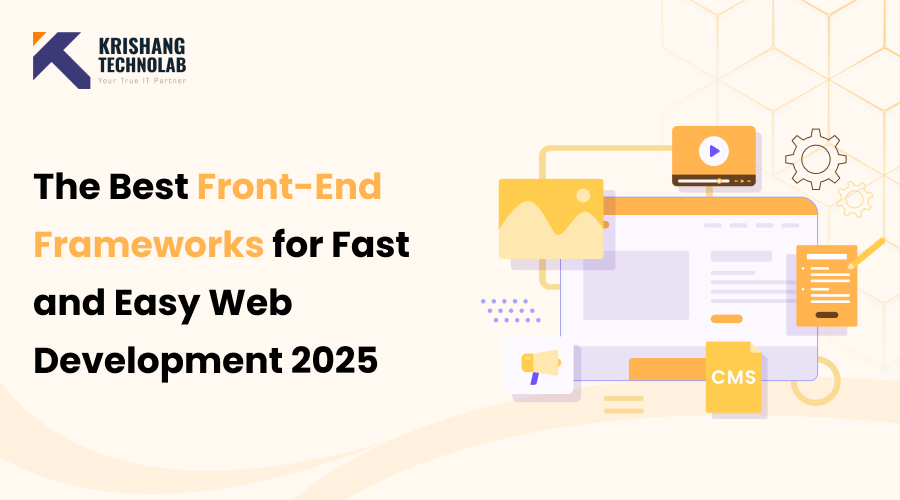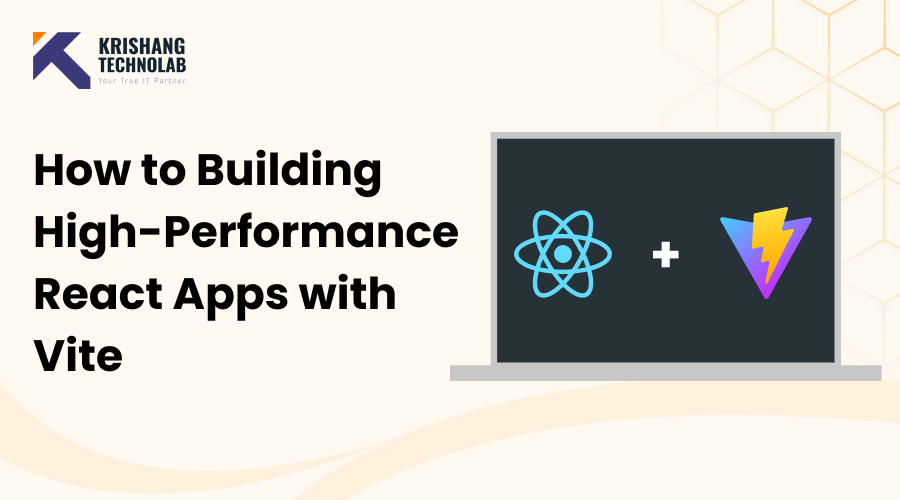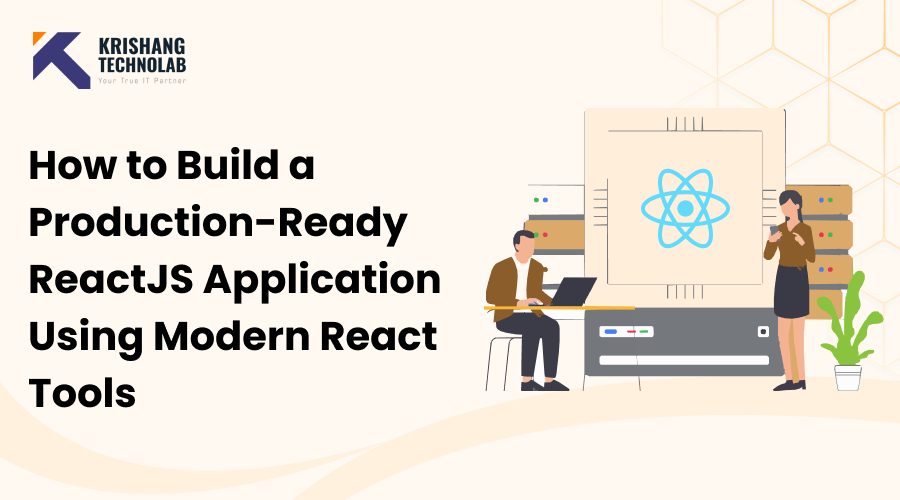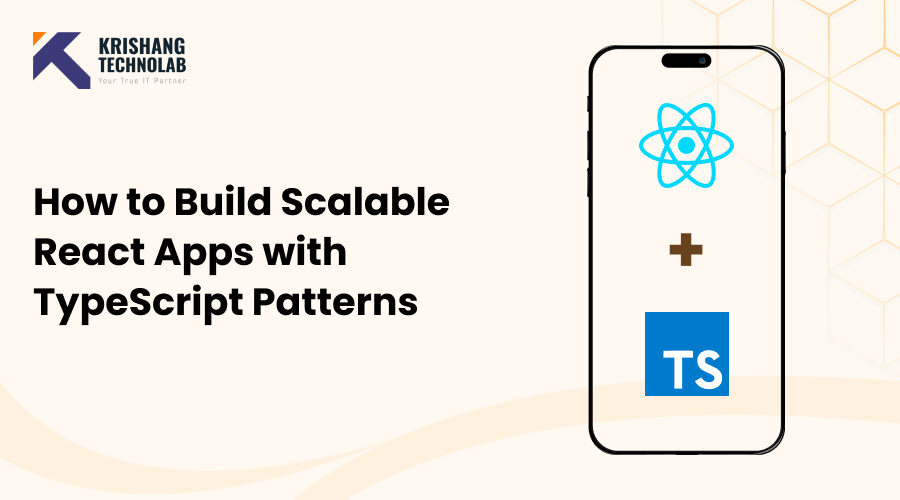Quick Overview: We talk about the best front-end frameworks to use in 2025 and why they are important for web development now in this blog. We talk about the most important features, strengths, and greatest use cases of React, Angular, Vue, and newer frameworks like Svelte, Tailwind, and Next.js. This short tutorial will help you pick the best framework for your next project.
Like everything else, the front-end web development landscape is all set to evolve as we move into the year 2025. The last year saw some remarkable shifts as certain technologies declined in usage while others gained prominence. This year, developers expect a lot from the front-end framework, and it is quite helpful for them to know about the best front-end frameworks ahead of time.
Web app developers are continuously seeking frameworks that not only streamline the development process but also enhance the overall user experience. In this blog, we are going to highlight these top front-end frameworks that developers swear by. However, before we dive in let’s revisit the basics and understand what front-end frameworks are all about.
What are front-end frameworks?
Front-end frameworks are pre-written collections of standardized HTML, CSS, and JavaScript code that enable developers to build responsive and interactive web applications. Over the past few years, front-end frameworks have become essential tools for building highly efficient web applications.
With the best predefined components, reusable components, design patterns, it improves the overall performance of the application and saves quite a lot of time on the development.
Let’s talk about some of the notable features of front-end development frameworks
1. Component-based architecture
Many front-end frameworks, such as React and VueJS, construct UIs using component-based structures that allow for the creation of reusable components. This architecture improves the reusability to a great extent.
2. Virtual DOM
Some of the front-end frameworks including React use virtual DOM to enhance the performance by minimizing the direct updates to the actual DOM. This also results in faster rendering and better overall user experience.
3. Built-in Routing
Front-end frameworks like Angular and VueJS come with built-in routing systems to handle navigation between different pages without requiring any requirement of full-page reloads.
4. Two-way data binding
Some frameworks, such as Angular and Vue.js, support two-way data binding that ensure that the UI and underlying data model stay in sync with each other.
Now let’s have a detailed understanding of the top front-end frameworks of 2025
Now that we’ve covered the basics, let’s take a closer look at the best front-end frameworks you should consider in 2025.

1. React
Overview: Developed and maintained by Facebook (Meta), React has become one of the most popular front-end frameworks in recent years. Its flexibility and component-based architecture make it an essential tool for modern web development. Moreover React allows developers to build interactive user interfaces with a smooth user experience while also maintaining high performance. For the best performance in 2025, hire ReactJS developers from the trusted front-end development company.
Key features of ReactJS:
- Component-Based Architecture: React allows developers to break down the UI into small, reusable components.
- Virtual DOM: React uses a virtual DOM to optimize rendering, which improves performance by updating only parts of the DOM that have changed.
- React Hooks: React hooks allow developers to use state and lifecycle features without writing a class, making the code more concise and easy to maintain.
- Unidirectional Data Flow: React uses one-way data flow, making it easier to debug and understand how data changes.
- React Router: Developers use React Router to create single-page applications with navigation between different views or routes.
Related: Why should you opt to react native for mobile app development?
2. Angular
Overview: Angular is a comprehensive, open-source web application framework developed and maintained by Google. Unlike other frameworks Angular is known for its robust features, such as dependency injection, two-way data binding, and powerful tooling for building complex and enterprise-level applications.
Notable features of Angular:
- TypeScript-Based: Angular is built using TypeScript, a statically typed superset of JavaScript, which provides better tooling, enhanced code quality, and easier debugging.
- Two-Way Data Binding: Angular’s two-way data binding allows the view to reflect changes made to the model and vice versa, thereby simplifying data management.
- Dependency Injection: Angular’s built-in dependency injection system helps in managing services and ensures the loose coupling of components.
- CLI (Command Line Interface): Angular CLI provides a command-line interface for managing project setup, development, and testing, thus making development more efficient.
- RxJS: Angular uses RxJS (Reactive Extensions for JavaScript) for managing asynchronous data streams, which is essential for building complex, data-driven applications.
3. Vue.js
Overview: Vue.js is a progressive JavaScript framework used to build user interfaces and single-page applications (SPAs). Unlike Angular, it doesn’t have a steep learning curve, making it an excellent choice for beginners as well as experienced developers. According to the 2024 Stack Overflow Survey, 19.3% of developers use Vue.js regularly, making it the third most popular framework. As of now, Vue.js is globally used by renowned companies like Alibaba, Xiaomi, and Adobe.
Key Features of VueJS:
- Reactive Data Binding: Vue’s two-way data binding system is similar to Angular’s but simpler to implement and understand.
- Single-File Components: VueJS allows the developers to create single-file components that combine HTML, JavaScript, and CSS in one file for improved maintainability.
- Vue Router: Vue Router is a powerful routing library that enables the creation of SPAs with smooth navigation.
- Vuex: Vuex is a state management library for handling the state of large applications.
- Progressive Framework: Vue can be used to enhance existing projects incrementally or be used for building full-fledged SPA.
4. Tailwind CSS
Overview: Tailwind CSS is a utility-first CSS front-end web development framework that provides low-level utility classes to construct custom designs without writing custom CSS. Unlike traditional CSS frameworks (like Bootstrap), it allows developers to build fully custom layouts. In 2024, it became the most popular CSS framework among front-end developers and in 2025, it is expected to hit the headlines as well.
Key features of Tailwind CSS:
- Utility-First Approach: Tailwind offers a set of utility classes that developers can combine to style elements without writing custom CSS.
- Responsive Design: Tailwind’s mobile-first, responsive utilities make it easy to design layouts that work across all screen sizes.
- Customizable: Tailwind’s configuration file allows developers to customize colors, spacing, fonts, and more to match the project’s design needs.
- No Opinionated Styles: Since it doesn’t impose a predefined design, Tailwind offers developers complete freedom in styling, resulting in unique and customized UI.
Read more about: TailWind CSS vs. Bootstrap: Which CSS Framework is Best?
5. Next.js
Overview: Next.js is a React-based framework that allows developers to build for both server-rendered and static web applications with ease. It supports both static site generation (SSG) and server-side rendering (SSR), making it an excellent choice for SEO-friendly web applications.
Key features of Next.js
- SSR and SSG: Next.js supports both server-side rendering and static site generation, allowing developers to build high-performance, SEO-optimized websites.
- File-Based Routing: Next.js employs a file-based routing system, which means that it automatically routes pages based on the file structure, eliminating the need for additional configuration.
- API Routes: Developers can build full-stack applications by creating API routes inside the Next.js project.
- Automatic Code Splitting: Next.js automatically splits JavaScript bundles, which ensures that the necessary code loads and improves page load times.
6. Bootstrap
Overview: Bootstrap is a front-end CSS framework that helps developers create responsive, mobile-first websites quickly. It provides a comprehensive set of pre-designed UI components, including forms, buttons, navigation bars, and modals. In 2025, hire Bootstrap developers to develop the best mobile-first websites to power up your businesses. Bootstrap is still preferred for its prebuilt components and mobile-first design.
Key Features of Bootstrap:
- Responsive Grid System: Bootstrap includes a responsive 12-column grid system that adapts to various screen sizes.
- Prebuilt Components: Bootstrap provides a collection of reusable UI components, such as buttons, forms, navbars, and more.
- Customizable Themes: Bootstrap allows for easy customization of themes using its built-in variables and SASS support.
- JavaScript Plugins: Bootstrap includes JavaScript-based plugins for UI enhancements like modals, carousels, and tooltips.
7. jQuery
Overview: jQuery is a fast, lightweight JavaScript library that simplifies HTML document traversal, event handling, and animation. Even though its popularity has declined with the rise of modern JavaScript frameworks, it still remains in use in many legacy applications.
Key features of JQuery:
- DOM Manipulation: jQuery simplifies DOM traversal and manipulation, allowing developers to interact with HTML elements with ease.
- Cross-Browser Compatibility: One major advantage of jQuery is that it resolves cross-browser issues, ensuring that code runs smoothly across different browsers.
- AJAX Support: jQuery provides built-in methods for making asynchronous HTTP requests and handling responses.
8. Ember.js
Overview: Ember.js is an opinionated, full-featured JavaScript framework for building ambitious web applications. Unlike some other frameworks, Ember provides a comprehensive set of tools, including a powerful router and built-in state management.
Key features of EmberJS:
- Convention over Configuration: Unlike frameworks that require extensive setup, Ember follows a strict convention-driven approach, reducing the need for configuration and making it easier to adopt best practices.
- Two-Way Data Binding: Ember provides two-way data binding, ensuring that changes in the UI reflect in the data model and vice versa.
- Router: Ember’s router is one of its most notable features, providing advanced handling of URLs and state transitions.
- Built-in State Management: Ember comes with its own state management system, Ember Data, which simplifies data handling.
9. Backbone.js
Overview: Backbone.js is a lightweight JavaScript framework that provides minimal structure for web applications. Unlike full-fledged frameworks, Backbone gives developers the flexibility to build complex applications with custom functionality.
Remarkable features of Backbone.js:
- Model-View-Controller (MVC) Pattern: Backbone.js enforces the MVC pattern, making it easier to structure web applications and maintain clean separation between data, logic, and UI.
- RESTful Interface: Additionally Backbone.js provides an easy way to interact with RESTful APIs by using its built-in model and collection objects.
- Event-Driven Architecture: Since Backbone.js allows for easy event handling, helping in managing interactions between different components.
10. Svelte
Overview: Svelte is an innovative framework that compiles down to efficient vanilla JavaScript at build time. Unlike React or Vue, Svelte does not rely on a virtual DOM, making applications significantly faster.
Stand out features of Svelte:
- Compile-Time Optimization: Unlike traditional frameworks, Svelte compiles components into efficient JavaScript, resulting in smaller bundle sizes and faster performance.
- No Virtual DOM: Since Svelte does not rely on a virtual DOM, which reduces the overhead of diffing and patching the DOM.
- Reactive Programming: Moreover Svelte makes it easy to manage state and data changes by automatically updating the DOM when state changes.
- Simple Syntax: Finally Svelte syntax is minimalistic, making it easy to learn and use, even for beginners.
11. Semantic UI
Overview: Semantic UI is a CSS framework designed to create responsive, modern websites with minimal effort. Unlike traditional CSS framework It uses human-readable HTML and provides a variety of UI components like buttons, forms, menus, and modals, with an easy-to-use syntax.
Key features of Semantic UI:
- Human-Readable Class Names: Unlike other CSS frameworks, Semantic UI uses meaningful class names that improve code readability and maintainability.
- Prebuilt Themes: It includes a range of themes and styles that can be easily customized to fit the project.
- Comprehensive UI Components: Semantic UI provides a wide array of UI components, including buttons, modals, dropdowns, and progress bars.
- Integration with React, Angular, and Vue: Furthermore Semantic UI can be integrated with popular JavaScript frameworks for enhanced functionality.
Conclusion: Which Front-End Frameworks is Best for You?
Each front-end framework has its strengths, and the best choice depends on your project’s needs:
- For Component-Based Development: React, Vue.js, and Svelte are great choices.
- For Enterprise-Grade Applications: Angular and Ember.js offer powerful features and scalability.
- For Performance-Optimized Web Apps: Next.js and Svelte stand out.
- For Styling and UI Design: Tailwind CSS, Bootstrap, and Semantic UI provide flexible and efficient design solutions.
- For Simplicity & Lightweight Projects: Backbone.js and jQuery can be useful in certain cases.
Choosing the right framework in 2025 will depend on your specific requirements, team expertise, and project complexity. No matter which you pick, mastering a front-end framework will significantly enhance your web development capabilities.
Which one suits your requirements the best? Get the right consultation.
After going through the list of best front-end frameworks in 2025, it’s time to pick the right one for you as per your requirements. If you are confused between these best front-end development frameworks, getting the right consultation from the right front-end development experts is the way ahead.
Krishang Technolab is your go-to partner for front-end JavaScript frameworks. With the right expertise, we are not just experts in front end development moreover, we also provide the right consultation so that your project outshines the rest Let’s glide into 2025 together and take your business a notch up.
Would you like expert guidance on choosing the right framework for your next project? Hire front-end developers today and build fast, scalable, and high-performing web applications!









